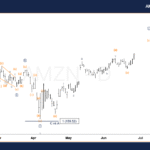What if I told you that one straightforward habit could put an extra $1,000 back in your pocket monthly? It sounds too good to be true, but it’s not. The secret isn’t about extreme couponing, living like a hermit, or giving up everything you enjoy. Instead, it’s about mastering one powerful habit that busy families everywhere use to slash their most significant expense after housing and transportation.
Americans tend to overspend the most on food in their budgets. Food costs can easily spiral out of control between rushed grocery store trips, last-minute takeout orders, and impulse purchases. But here’s the game-changer: families spending just one hour each week on meal planning save around $500 monthly. That’s $6,000 annually– many families are doubling that amount. The habit that’s transforming budgets across the country is strategic meal planning, and it’s about to change your financial life forever.
The $12,000 Breakdown: How Meal Planning Saves Real Money
The numbers behind meal planning are staggering when you break them down. The average family spends between $300 and $500 per month dining out, while the same meals cooked at home cost just $150 to $200. That’s an immediate monthly savings of $150 to $350 from eating more meals at home. But the savings don’t stop there.
Without a meal plan, people wander through grocery stores, trying to decide what to cook while creating shopping lists from memory. This leads to overspending on their entire weekly budget, plus inevitable return trips for forgotten items. Impulse purchases can add 30-40% to grocery bills, while poor planning leads to food waste that throws money straight into the trash. Savvy meal planners are making a week’s worth of dinners for around $50 by using all their ingredients efficiently and shopping with purpose.
Why Meal Planning Works: The Psychology Behind the Savings
Meal planning eliminates decision fatigue – that mental exhaustion that hits when you’re staring into an empty fridge at 5 p.m., wondering what to make for dinner. When you’re tired and hungry, you’re much more likely to make expensive last-minute choices like ordering pizza or running to the grocery store, where you’ll inevitably buy more than you need. Decision fatigue is costly, and meal planning eliminates it.
The habit also creates intentional spending, which is the foundation of all successful frugal living. Instead of reactive spending based on immediate hunger or convenience, you’re making deliberate choices that align with your budget and goals. This intentional approach often creates a ripple effect, inspiring other money-saving habits throughout your life. When you succeed at meal planning, you build confidence in your ability to control your finances in different areas.
1. Inventory First, Plan Second
The biggest mistake most people make is planning meals based on what they want to eat and then shopping for everything from scratch. Savvy meal planners completely flip this approach. They start by shopping their own fridge, pantry, and freezer to see what they already have. This isn’t just about being organized—it’s about recognizing that everything in your kitchen represents money you’ve already spent.
Look for items that need to be used soon, like dairy products approaching their expiration date or vegetables starting to wilt. Build your weekly menu around these items first. If you have milk that needs to be used, plan to make a cream-based soup or pancakes for dinner. If you have frozen vegetables in your freezer space, incorporate them into stir-fries or casseroles. This simple step can cut your grocery spending by 30% or more each week.
2. Strategic Menu Creation
Once you know what you’re working with, it’s time to create your weekly menu strategically. The key is choosing recipes that share ingredients across multiple meals and can be transformed into new dishes throughout the week. For example, if you buy a large package of ground beef, plan to use it for tacos one night, spaghetti sauce another night, and shepherd’s pie later in the week.
Pay attention to your schedule when planning meals. Match complex recipes that require more time and attention to days when you’ll be home early and feeling energetic. Save slow cooker meals, simple pasta dishes, and leftover transformations for busy weeknights when you rush between work and activities. This prevents the temptation to give up and order takeout when life gets hectic.
3. Smart Shopping Execution
Create a detailed shopping list organized by store sections with your strategic menu. This makes your shopping trip faster and more focused, reducing the time you spend wandering aisles where impulse purchases lurk. The quickest way to destroy your grocery budget is by buying random items from those eye-catching end-cap displays that have nothing to do with your planned meals.
Stick to your list religiously, with minimal exceptions for truly forgotten necessities. Consider generic brands for staple items – even professional chefs use store brands because they often contain similar ingredients and quality for significantly less money. If you’re shopping sales, only buy sale items that fit into your planned meals or that you can realistically use before they expire.
4. Prep and Batch Systems
The final step that turns meal planning from a good idea into serious savings is thoughtful preparation. Spend time on your shopping day or washing, chopping, and portioning ingredients the next day. This prevents you from paying the premium that comes with pre-cut vegetables and prepared foods. An hour of prep work can save you $50 or more per week than buying convenience items.
Batch cooking is where the real magic happens. When making taco meat, double or triple the recipe and freeze the extra portions in meal-sized containers. When cooking chicken breasts, prepare extra for quick meals later in the week. This strategy ensures you always have fast, homemade options, eliminating the temptation to order expensive takeout on busy nights.
Case Study: Bonnie’s $800 Monthly Savings
Bonnie spent nearly $1,200 monthly feeding her family between grocery bills and frequent restaurant visits. She constantly scrambled for meal solutions between her demanding job and her children’s busy schedules. Most weeks included at least four takeout dinners, weekend restaurant meals, and grocery shopping trips that never seemed to have a clear purpose. She felt like she was always buying food, but never had anything good to eat.
Everything changed when Bonnie committed to spending one hour every Sunday planning her family’s meals. She started by taking inventory of what was already in her kitchen, often discovering forgotten ingredients that had been pushed to the back of her pantry. She began planning meals around these existing items and the weekly sale ads from her local grocery store. Instead of multiple random shopping trips, she made one focused trip with a detailed list organized by store sections.
The results were immediate and dramatic. Bonnie’s grocery bills dropped from $400-500 per month to around $200, while her restaurant spending fell to just one special dinner out per week. She started batch cooking on Sundays, preparing ingredients and even full meals that could be quickly reheated during busy weeknights. Within three months, she saved over $800 per month – nearly $10,000 per year – while eating better food and feeling less stressed about meals.
Key Takeaways
- Meal planning can save families $750-1,000 per month through reduced dining out and smarter grocery shopping.
- Starting with a kitchen inventory prevents food waste and maximizes ingredients you’ve already purchased.
- Strategic menu planning using shared ingredients across multiple meals stretches your grocery budget significantly.
- Shopping with a detailed, organized list prevents costly impulse purchases that add 30-40% to grocery bills.
- Batch cooking and meal prep eliminate the temptation for expensive last-minute food solutions.
- Generic brands offer similar quality to name brands while costing significantly less money.
- Matching meal complexity to your daily schedule prevents the urge to abandon cooking for takeout.
- One focused weekly shopping trip saves more money than multiple spontaneous grocery visits.
- Meal planning eliminates decision fatigue that leads to expensive food choices when you’re tired and hungry.
- The habit creates a foundation for other frugal behaviors and builds confidence in financial management.
Conclusion
Meal planning isn’t just about saving money – it’s about taking control of one of your most significant expenses and turning it into a tool for financial success. The families saving $12,000 annually through this simple habit aren’t depriving themselves or eating bland food. They’re eating better while spending less and doing it without the stress and chaos that comes with constant last-minute meal decisions. The time investment is minimal, but the financial impact is life-changing.
The best part about meal planning is that it gets easier and more effective the longer you do it. You’ll develop a repertoire of go-to recipes, learn which strategies work best for your family’s schedule, and build systems that make the whole process nearly automatic. Start with just one week, track your savings, and watch as this single habit transforms not just your food budget, but your entire approach to money management. Your bank account will thank you, and you might discover that planning makes life more enjoyable, not less.






